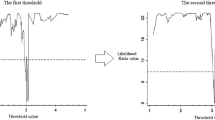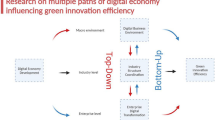Abstract
In the past 20 years, the green economy has increasingly attracted the attention of governments and policy makers. However, most studies have only focused on the relationship between the green economy and innovation, and little attention has been given to the relationship between the different innovation stages and the green economy. This study draws on eco-innovation and institutional theories and proposes a model to empirically investigate the effects between the different innovation stages and green economy. Furthermore, it explores how these effects are mediated by knowledge spillover and moderated by absorptive capacity and environment regulations. We use data from the last 5 years (2012–2016) obtained from different China regions to empirically test the model. Results show that knowledge innovation, research and development (R&D) innovation, and product innovation have the same significant positive impact on knowledge spillovers. R&D and product innovation have a significant positive impact on green economy, whereas knowledge innovation has no significant effect on the development of the green economy. Knowledge spillover partially mediates the relationship between the innovation stage and the green economy. Meanwhile, absorptive capacity positively moderates the relationship between knowledge spillover and the green economy. However, environmental regulation negatively moderates the relationship between knowledge spillover and the green economy. In addition, corresponding measures are proposed based on the conclusions.



Similar content being viewed by others
References
Abd Elmonem Shamah R, Elssawabi SM (2015) Facing the open innovation gap: measuring and building open innovation in supply chains. J Model Manag 10(1):50–75
Akgun AE, Keskin H, Byrne JC, Aren S (2007) Emotional and learning capability and their impact on product innovativeness and firm performance. Technovation 27(9):501–513
Akhavan P, Hosseini SM (2016) Social capital, knowledge sharing, and innovation capability: an empirical study of R&D teams in Iran. Tech Anal Strat Manag 28(1):96–113
Anderson TR, Daim TU, Lavoie FF (2007) Measuring the efficiency of university technology transfer. Technovation 27(5):306–318
Arrow KJ (1962) Economic welfare and the allocation of resources for invention. In: Nelson R (ed) The rate and direction of inventive activity. Princeton University Press and NBER, NJ
Archambault, É (2002) Methods for using patents in cross-country comparisons. Scientometrics, 54(1), 15–30
Archibugi D, Pianta M (1996) Innovation surveys and patents as technology indicators: the state of the art. Innovation, Patents and Technological Strategies. Paris, OECD
Audretsch DB, Keilbach M (2008) Resolving the knowledge paradox: knowledge-spillover entrepreneurship and economic growth. Res Policy 37(10):1697–1705
Batabyal AA, Nijkamp P (2014) Positive and negative externalities in innovation, trade, and regional economic growth. Geogr Anal 46(1):1–17
Bocken NMP, Farracho M, Bosworth R, Kemp R (2014) The front-end of eco-innovation for eco-innovative small and medium sized companies. J Eng Technol Manag 31:43–57
Bossle MB, Dutra de Barcellos M, Vieira LM, Sauvée L (2016) The drivers for adoption of eco-innovation. J Clean Prod 113:861–872
Cai W, Li G (2018) The drivers of eco-innovation and its impact on performance: evidence from China. J Clean Prod 176:110–118
Cai W, Zhou X (2014) On the drivers of eco-innovation: empirical evidence from China. J Clean Prod 79:239–248
Camisón C, Villar-López A (2014) Organizational innovation as an enabler of technological innovation capabilities and firm performance. J Bus Res 67(1):2891–2902
Carley M, Spapens P (2017) Sharing the world: sustainable living and global equity in the 21st century. London, Routledge
Chung MY, Lee K (2015) How absorptive capacity is formed in a latecomer economy: different roles of foreign patent and know-how licensing in Korea. World Dev 66:678–694
Cohen WM, Levinthal DA (1990) Absorptive capacity: a new perspective on learning and innovation. Adm Sci Q 35:128–152
Cooke P (2010) Regional innovation systems: development opportunities from the ‘green turn’. Tech Anal Strat Manag 22(7):831–844
Cruz-Gonzalez J, Lopez-Saez P, Emilio Navas-Lopez J (2015) Absorbing knowledge from supply-chain, industry and science: the distinct moderating role of formal liaison devices on new product development and novelty. Ind Mark Manag 47(75–85):75–85
Czarnitzki Dm, Ebersberger B, & Fier A (2007) The relationship between R&D collaboration, subsidies and R&D performance: empirical evidence from Finland and Germany. Journal of Applied Econometrics, 22(7), 1347–1366
Da-jian Z (2012) New concept of green economy and consideration of deepening green economy studies in China [J]. China Popul Resour Environ 22(5):40–47
Egbetokun A, Savin I (2014) Absorptive capacity and innovation: when is it better to cooperate? J Evol Econ 24(2):399–420
Ferragina AM, Mazzotta F (2014) FDI spillovers on firm survival in Italy: absorptive capacity matters! J Technol Transfer 39(6):859–897
Findlay R (1978) Relative backwardness, direct foreign investment, and the transfer of technology: a simple dynamic model. Q J Econ 92(1):1–16
Foxon T, Pearson PJ (2007) Towards improved policy processes for promoting innovation in renewable electricity technologies in the UK. Energy Policy 35(3):1539–1550
Galende J (2006) Analysis of technological innovation from business economics and management. Technovation 26(3):300–311
Ghisetti C, Marzucchi A, Montresor S (2015) The open eco-innovation mode. An empirical investigation of eleven European countries. Res Policy 44(5):1080–1093
Healy A, Morgan K (2012) Spaces of innovation: learning, proximity and the ecological turn. Reg Stud 46(8):1041–1053
Horbach J, Rammer C, Rennings K (2012) Determinants of eco-innovations by type of environmental impact — the role of regulatory push/pull, technology push and market pull. Ecol Econ 78:112–122
Kammerer D (2009) The effects of customer benefit and regulation on environmental product innovation: empirical evidence from appliance manufacturers in Germany. Ecol Econ 68(8–9):2285–2295
Kang W, Zhao S, Song W, Zhuang T (2019) Triple helix in the science and technology innovation centers of China from the perspective of mutual information: a comparative study between Beijing and Shanghai. Scientometrics 118(3):921–940
Kemp R, Pearson P (2008) Measuring eco-innovation final report MIE project, UNU-MERIT, Maastricht
Kesidou E, Demirel P (2012) On the drivers of eco-innovations: empirical evidence from the UK. Res Policy 41(5):862–870
Kim H, Kim Y, Cho K (2014a) The effect of research and development investment and desorptive capacity on firm performance. Asian J Technol Innov 22(2):252–267
Kim Y, Lim HJ, Lee SJ (2014b) Applying research collaboration as a new way of measuring research performance in Korean universities. Scientometrics, 99(1), 97–115
Klewitz J, Hansen EG (2014) Sustainability-oriented innovation of SMEs: a systematic review. J Clean Prod 65:57–75
Levidow L, Blind M, Lindgaard-Jorgensen P, Nilsson A, Skenhall SA (2016) Industry eco-innovation strategies for process upgrading: systemic limits of internalising externalities. Tech Anal Strat Manag 28(2):190–204
Lin H, Zeng SX, Ma HY, Qi GY, Tam VWY (2014) Can political capital drive corporate green innovation? Lessons from China. J Clean Prod 64:63–72
Lin S, Wang S, Marinova D, Zhao D, Hong J (2017) Impacts of urbanization and real economic development on CO 2 emissions in non-high income countries: empirical research based on the extended STIRPAT model. J Clean Prod 166:952–966
Massini S, Lewin AY, Greve HR (2005) Innovators and imitators: organizational reference groups and adoption of organizational routines. Res Policy 34(10):1550–1569
Nielsen BB (2005) The role of knowledge embeddedness in the creation of synergies in strategic alliances. J Bus Res 58(9):1194–1204
Nieto M, Quevedo P (2005) Absorptive capacity, technological opportunity, knowledge spillovers, and innovative effort. Technovation 25(10):1141–1157
Petit ML, Sanna-Randaccio F, Sestini R (2009) Asymmetric knowledge flows and localization with endogenous R&D: a dynamic analysis. Econ Model 26(2):536–547
Phillimore J (2001) Schumpeter, Schumacher and the greening of technology. Tech Anal Strat Manag 13(1):23–37
Popp D (2002) Induced innovation and energy prices. Am Econ Rev 92(1):160–180
Pujari D (2006) Eco-innovation and new product development: understanding the influences on market performance. Technovation 26(1):76–85
Ritala P, Sainio L-M (2014) Coopetition for radical innovation: technology, market and business-model perspectives. Tech Anal Strat Manag 26(2):155–169
Romer PM (1986) Increasing returns and long-run growth. J Polit Econ 94(5):1002–1037
Ryzhkova N, Pesämaa O (2015) Absorptive capacity, collaboration with customers and innovation performance of gazelle companies in knowledge-intensive industries. Int J Innov Manag 19(05):1–27
Salomon R, Jin B (2008) Does knowledge spill to leaders or laggards? Exploring industry heterogeneity in learning by exporting. J Int Bus Stud 39(1):132–150
Shen N, Liu FC (2012) Can high-intensity environmental regulation really promote technological innovation. China Soft Sci 4:49–59
Solow RM (1957) Technical change and the aggregate production function. Rev Econ Stat 39:312–320
Stolpe M (2002) Determinants of knowledge diffusion as evidenced in patent data: the case of liquid crystal display technology. Res Policy 31(7):1181–1198
Tether BS, Tajar A (2008) Beyond industry-university links: sourcing knowledge for innovation from consultants, private research organisations and the public science-base. Res Policy 37(6–7):1079–1095
Triguero A, Moreno-Mondéjar L, Davia MA (2013) Drivers of different types of eco-innovation in European SMEs. Ecol Econ 92:25–33
Tsai K-H (2009) Collaborative networks and product innovation performance: toward a contingency perspective. Res Policy 38(5):765–778
Wang K, Lu B, Wei Y-M (2013) China’s regional energy and environmental efficiency: a range-adjusted measure based analysis. Appl Energy 112:1403–1415
Xuemei X, Jiage H, Guoyou Q, Zhu KX (2016) Green process innovation and financial performance in emerging economies: moderating effects of absorptive capacity and green subsidies. IEEE Trans Eng Manag 63(1):101–112
Yam RCM, Lo W, Tang EPY, Lau AKW (2011) Analysis of sources of innovation, technological innovation capabilities, and performance: an empirical study of Hong Kong manufacturing industries. Res Policy 40(3):391–402
Yang H, Phelps C, Steensma HK (2010) Learning from what others have learned from you: the effects of knowledge spillovers on originating Frims. Acad Manag J 53(2):371–389
Yu W, Ramanathan R, Nath P (2017) Environmental pressures and performance: an analysis of the roles of environmental innovation strategy and marketing capability. Technol Forecast Soc Chang 117:160–169
Zhao SL, Cacciolatti L, Lee SH, Song W (2015) Regional collaborations and indigenous innovation capabilities in China: a multivariate method for the analysis of regional innovation systems. Technol Forecast Soc Chang 94:202–220
Author information
Authors and Affiliations
Corresponding author
Additional information
Responsible editor: Philippe Garrigues
Publisher’s note
Springer Nature remains neutral with regard to jurisdictional claims in published maps and institutional affiliations.
Rights and permissions
About this article
Cite this article
Zhao, S., Jiang, Y. & Wang, S. Innovation stages, knowledge spillover, and green economy development: moderating role of absorptive capacity and environmental regulation. Environ Sci Pollut Res 26, 25312–25325 (2019). https://doi.org/10.1007/s11356-019-05777-9
Received:
Accepted:
Published:
Issue Date:
DOI: https://doi.org/10.1007/s11356-019-05777-9




